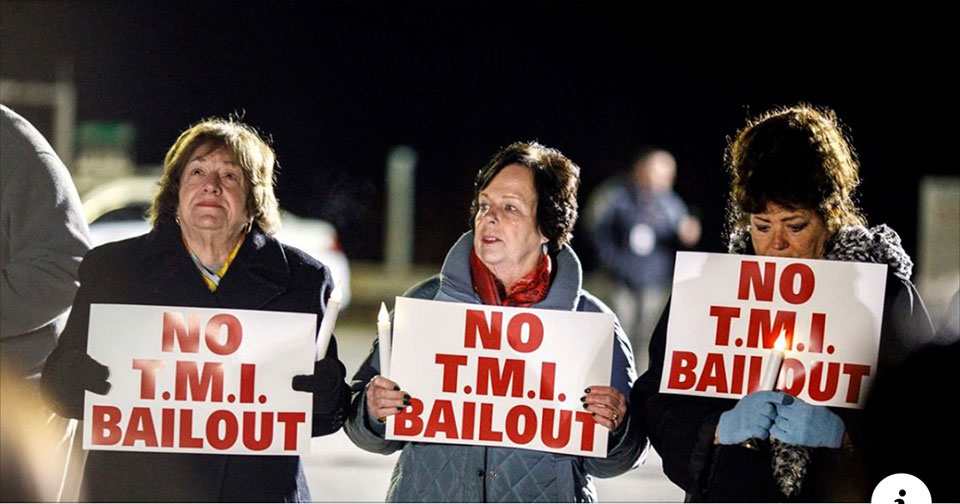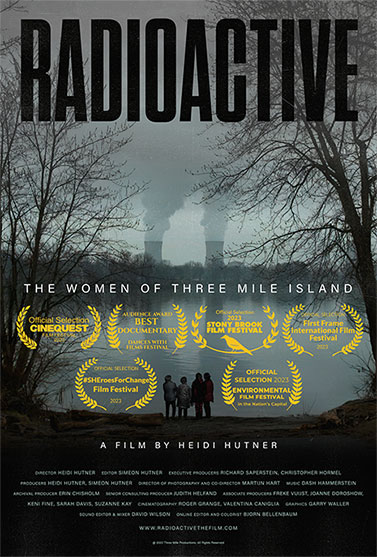According to attorney Lynne Bernabei, what happened at Three Mile Island “is one of the biggest coverups in history that hasn’t been uncovered” — until now, that is. Heidi Hutner’s award-winning documentary Radioactive: The Women of Three Mile Island chronicles what happened after the partial meltdown of the reactor core at the Three Mile Island Nuclear Generating Station in Harrisburg, Pennsylvania, on March 28, 1979. Hutner, an environmental humanities professor at Stony Brook University, documents the experience of four alarmed women who lived near the facility at the time and who dared question industry spokespeople and government authorities about what was happening at the damaged plant.

They were largely dismissed, and in one case they were even told by a government official to “go home and bake cookies.” Instead, they formed a group called Concerned Mothers and Women, organizing grassroots resistance to the nuclear industry and its state and federal enablers. The fear of their families becoming radioactive inspired Joyce Corradi, Paula Kinney, Beth Drazba, and Linda Braasch — “typical moms and apple-pie Americans,” as Corradi puts it — to become activists in the wake of what Walter Cronkite called “a nuclear nightmare.”
Exactly how bad the Three Mile Island accident was is subject to debate. Radioactive interviewees contend industry spokespeople and government officials lied to the public, minimizing what they say was a major risk. In the film, Aaron Datesman, a former NASA senior detector engineer, says the meltdown of the plant’s Unit 2 reactor released radioactive gases and created a “massive hydrogen bubble” that threatened to blow the plant up “like an atom bomb.” A whistleblower, whose face is obscured to protect his identity, alleges that the meltdown exposed nearby communities — including those that evacuated to neighboring cities during the disaster — to iodine-131, which has been linked to thyroid cancer.
Radioactive goes back and forth in time from the present day to the months and years immediately following the disaster. By interweaving original interviews with news clips and archival footage filmed back in the day, the documentary conveys a sense of how the tragedy transformed and bonded Corradi, Kinney, Drazba, and Braasch.

In addition to relying on one another and engaging in activism, after being confronted by radiation sickness compounded by corporate and government betrayal, Braasch turned to a higher force: “I got in a relationship with Jesus Christ. Faith in God keeps me going.”
But the disaster has also taken its toll on these activists. Corradi reveals she’s a cancer survivor, one of many residents near the impaired nuclear power plant who developed cancer and other ailments that, Radioactive argues, may be directly tied to the nuclear mishap there four decades ago. Linda’s husband, Dan Steele Brasch, discloses he has cancer of the esophagus, but considers himself “lucky” because it was discovered in early stages. Unfortunately, many others who lived near the disaster’s ground zero died.
Concerned Mothers and Women is the heart of Radioactive, but the film also interviews others, notably two-time Oscar winner Jane Fonda, whose activism is as legendary as her acting is. The outspoken actress combined both in The China Syndrome, a 1979 film that depicts a nuclear emergency at a fictitious power plant — and was coincidentally released just before the Three Mile Island accident. In an interview, Fonda tells Hutner: “We all knew it was an important movie. Everybody went rushing to see The China Syndrome to find out what really happened at Three Mile Island.”
Joanne Doroshow — who was at the time lead counsel and spokeswoman for TMI Alert, a community group seeking to prevent restarting the TMI-1 nuclear reactor after the accident — is also interviewed, asserting onscreen that “as a result of [the TMI experience] I became a powerful woman. It changed my life.” In another interview Renu Joshi, a thyroid disease expert, confesses: “I’d never live near a nuclear plant. Why take a chance?”
Indeed, the feminist, anti-nuclear film asks this question broadly, especially as nuclear power is being considered as an alternative energy source amid the climate crisis. In that great cinematic tradition stretching back to silent movies, the film ends with a cliffhanger: Corradi, Kinney, Drazba, and Braasch take blood tests that could determine whether their chromosomes have abnormalities caused by radiation. What will the results reveal? What is the true cost of nuclear power?
We don’t have a paywall because, as a nonprofit publication, our mission is to inform, educate and inspire action to protect our living world. Which is why we rely on readers like you for support. If you believe in the work we do, please consider making a tax-deductible year-end donation to our Green Journalism Fund.
DonateGet four issues of the magazine at the discounted rate of $20.